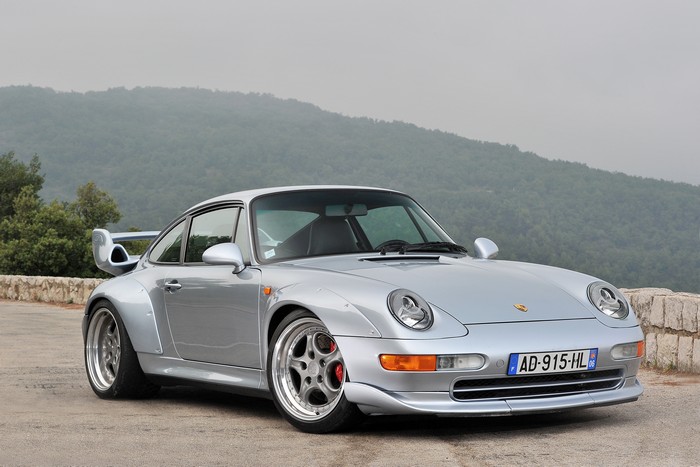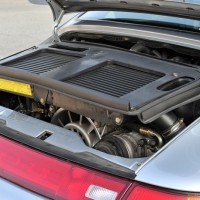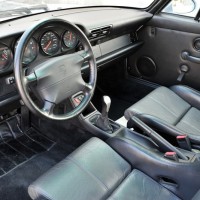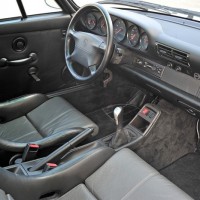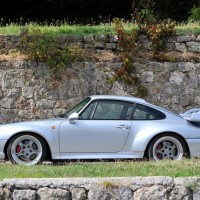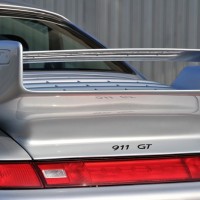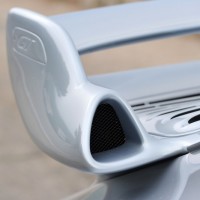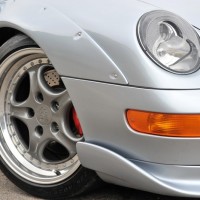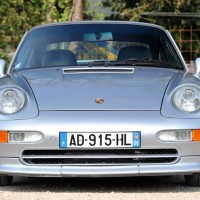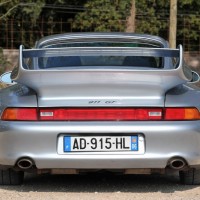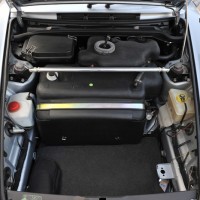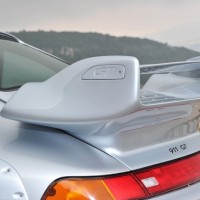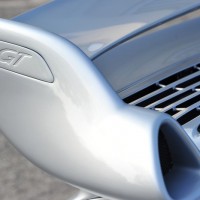When Porsche introduced the new 993 in 1995, it was to be the last of the great air-cooled 911s. The new coupe retained only the roof and front deck lid from the preceding 964 model.
New items included bodywork, poly-ellipsoid low-beam and variable-focus high-beam headlights, and a 6-speed transmission. A new multi-link rear suspension carried upper and lower A-arms with transverse links. Both the front and rear sub-frames were now so strong that if they were bent in a crash they had to be replaced — they could not be straightened. There were new wheels, and the brake discs and pads were enlarged.
Porsche’s success with the four-wheel-drive 961, Audi’s rally wins with the Quattro, and the later track success of the Nissan Skyline had led to all-wheel-drive being banned by most sanctioning bodies by the mid-1990s. This presented a problem for Porsche, whose Turbo was fitted with 4-wheel drive; the solution was the GT2, which was built with rear drive only. A side benefit turned out to be significant weight savings, and the GT2 was instantly competitive.
For example, Dave Maraj of Champion Porsche in Pompano Beach, FL, bought s/n 393062 in January 1995, and it proved to be a constant threat in IMSA in the hands of Hans Stuck Jr., Derek Bell, Thierry Boutsen and Bill Adam. In its Champion DayGlo colors, the car was Second in Class at the 1995 Sebring 12-Hours, Second in Class at Watkins Glen, it won its class at the 1996 Sebring 12-Hours, and it placed Second in Class at 1997 Daytona 24-Hours.
A side-effect of all this competition success was that Porsche had to build a number of street GT2s in order to homologate the model for racing. At about 430 horsepower, they ran higher boost than the street Turbo model and developed almost as much horsepower as the racers. They shared cutaway fenders with the Carrera RS and had removable and replaceable bolt-on flares in order to fit wider wheels for racing and quickly fix crash damage.
This original and unmodified Porsche GT2 is offered in perfect condition, with the most recent major service conducted in 2012 by Porsche in Geneva. Offered with French registration, road-going GT2s very seldom come to market, and those that do seldom have a more sparkling résumé than the example offered here today. Many road cars were converted to race cars in period, so the opportunity to acquire a totally unmolested low-mileage and low-ownership example is one not to be missed by the discerning Porsche collector.
SCM Analysis
Detailing
| Vehicle: | 1996 Porsche 911S GT2 |
| Number Produced: | 57 |
| Tune Up Cost: | $950 for 12,000-mile service |
| Chassis Number Location: | Stamped in trunk floor under spare wheel |
| Engine Number Location: | Right side of cooling fan cover |
| Club Info: | Porsche Club of America |
| Website: | http://www.pca.org |
This car, Lot 155, sold for $523,297 (£324,800), including buyer’s premium, at RM’s Automobiles of London auction at Battersea Evolution on October 31, 2012.
This is one of 57 factory-built, road-going homologation 993 GT2s, with a 430-hp twin-turbocharged 3.6-liter version of Porsche’s long-lived, air-cooled flat six. Chassis 392099 was supplied new to Switzerland by the Porsche main agent in Zurich and has had only two owners from new.
The French seller purchased it in 2005 from Swiss Porsche specialist and 1979 Le Mans class winner Angelo Pallavicini, with only 3,000 kilometers (1,864 miles) on the clock. It has obviously been used only sparingly since. The odometer read 15,922 km (9,893 miles) when it was photographed for the catalog and only 15,948 km at the sale — still less than 10,000 miles.
It has been maintained by Porsche main agents in Switzerland and Monaco, near to where it is registered in the Alpes-Maritimes region of southern France, and it has full dealer service history at a mileage when most cars would be coming up for their first oil change. Its original-color Polar Silver is unscuffed, although it may have been repainted, and its black/gray leather seats are only slightly worn. The wheels are unscuffed, and the drilled brake discs are in good order.
A rare and coveted Porsche
Porsche has been making a GT2 model since 1995, but, in the same way that the 993 is considered the last “real” 911 because it’s the final air-cooled car, there are those who would contend that the only “real” GT2 is the original. Essentially, it’s a stripped-out turbo with more power, following the formula that Porsche used when it hot-rodded the 2.4S to arrive at its 1973 masterpiece the RS 2.7. Certainly, the later 996-based cars are a lot cheaper to buy right now — at less than half the price of this car.
The 996 appeared in 1999 — its GT2 version didn’t appear until 2001 — and that was much more of a road car than its predecessor, needing its 462 horsepower and later 483 horsepower to combat the extra weight, as it had somehow flabbed out by 300 pounds.
When the 997 GT2 model appeared, it was even more powerful, with 523 horsepower, and faster (200 mph), but was heavier again. There is a bonkers “skunk works” 600-hp 997 RS GT2 that is 154 pounds lighter — yet still 160 pounds heavier than a 993 GT2 — and has lapped the Nürburgring in a claimed 7 minutes, 18 seconds. So, the 993 GT2 is the lightest and the rawest, having a similar appeal to the immortal RS 2.7 — and the homologation-special bloodline is there for all to see.
Climbing values
Unmolested road-trim GT2s rarely come to market. Shortly before the Battersea sale and not far from it, Hexagon Classics in Kensington, U.K., sold a right-hand-drive GT2 Club Sport — the only one made in Blood Orange — with 28,000 miles on the clock for “around £250k” ($405,000). As this was written, Hexagon was offering a left-hand-drive white car for £230k ($370k) — the difference in price was because it had been converted into a racer and then someways back into a road car again.
Both of those sales make our subject car look pricey to the tune of $100k.
“But that’s the way the market is going,” Hexagon’s Paul Giovanni said. “We’re finding that prices are skyrocketing at the moment.” Only seven of the 57 made were right-hand drive, but left-handers of any type will always command more because there’s a larger market for them.
It’s interesting to compare this car with that other collectible “don’t dare drive it” 911 derivative — the 959, of which there was one at the Battersea sale. Although these now look antique, this repainted example fetched $496,230, possibly because it had covered just 404 miles.
With both, again we have the quandary common to all low-mileage cars: While factory freshness is desirable from a marketing point of view, if you use them, they lose the very feature that confers their value.
But standing does them no good at all, as the owner of the 959 expensively found out when his car needed recommissioning before he could drive it. Perhaps, as a collectible that’s going to be mothballed, that doesn’t matter.
It may be that the new British owner of this car spotted where the market is going and got in fast, and a year’s passing will show him to have acted with foresight. Making it into a racer wouldn’t make any financial sense, so there is the obvious danger that it will enter a static collection. Not to drive one of these is a hell of a waste.
At this point, the car looks well sold — and soon might look well bought. ?
(Introductory description courtesy of Bonhams.)
